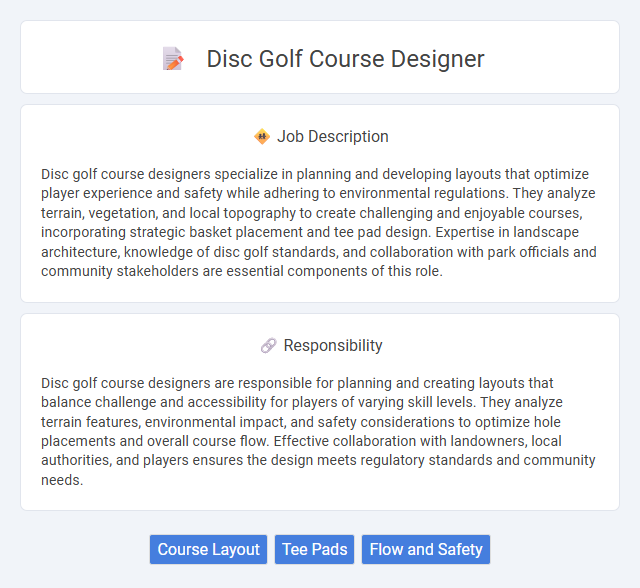
Disc golf course designers specialize in planning and developing layouts that optimize player experience and safety while adhering to environmental regulations. They analyze terrain, vegetation, and local topography to create challenging and enjoyable courses, incorporating strategic basket placement and tee pad design. Expertise in landscape architecture, knowledge of disc golf standards, and collaboration with park officials and community stakeholders are essential components of this role.
Individuals who enjoy outdoor activities and possess strong spatial awareness are likely to find a disc golf course designer job suitable. People with a passion for creativity and problem-solving may thrive in this role, as it involves crafting strategically challenging and visually appealing courses. Those who prefer routine indoor tasks or have limited interest in sports might face difficulties adapting to the dynamic and physically engaged nature of the job.
Qualification
Expertise in landscape architecture or sports facility design is essential for a disc golf course designer, alongside a strong understanding of disc golf rules and player skill levels. Proficiency in CAD software and environmental impact assessment ensures courses are both functional and sustainable. Experience coordinating with local authorities and community stakeholders enhances project approval and community engagement.
Responsibility
Disc golf course designers are responsible for planning and creating layouts that balance challenge and accessibility for players of varying skill levels. They analyze terrain features, environmental impact, and safety considerations to optimize hole placements and overall course flow. Effective collaboration with landowners, local authorities, and players ensures the design meets regulatory standards and community needs.
Benefit
A career as a disc golf course designer likely offers the benefit of combining creative landscape design with the growing popularity of disc golf, potentially leading to steady demand for innovative courses. Professionals in this field may enjoy opportunities to work outdoors, contributing to community recreation and environmental enhancement. The role could also provide a chance to influence the sport's development and receive recognition within niche sporting and landscaping communities.
Challenge
Designing a disc golf course likely involves complex challenges such as balancing natural terrain features with player skill levels to create an engaging experience. The job probably requires innovative problem-solving to optimize flow and safety while incorporating environmental considerations. The dynamic nature of outdoor conditions may also pose ongoing difficulties in maintaining course quality and playability.
Career Advancement
Disc golf course designers specialize in creating challenging and engaging layouts that enhance player experience and safety. Career advancement often involves gaining expertise in land assessment, environmental sustainability, and player psychology to secure higher-profile projects and collaborations with municipalities or private clubs. Mastery in design software and a solid portfolio can lead to roles such as senior designer, project manager, or consultant in the expanding disc golf industry.
Key Terms
Course Layout
Designing a disc golf course layout requires an expert understanding of terrain, natural obstacles, and player skill levels to create challenging and enjoyable holes. Course designers strategically position tees, baskets, and fairways to optimize flow and safety while maximizing environmental preservation. Incorporating elevation changes, diverse shot angles, and varying hole lengths enhances gameplay and appeals to a broad range of disc golf enthusiasts.
Tee Pads
Disc golf course designers specialize in creating strategic layouts that enhance player experience, with particular attention to tee pads that provide stable and durable launching surfaces. Tee pads are crafted from materials such as concrete, asphalt, or rubber mats to ensure consistent footing and reduce injury risk. Proper design considers pad size, slope, and placement to accommodate various skill levels and maximize course flow.
Flow and Safety
A disc golf course designer prioritizes seamless flow by strategically placing fairways and obstacles to create an engaging and intuitive player experience. Emphasizing safety, the designer ensures ample spacing between tees, fairways, and baskets to prevent player collisions and reduce the risk of errant disc injuries. Incorporating natural terrain and clear signage enhances both navigational ease and hazard awareness throughout the course.
 kuljobs.com
kuljobs.com